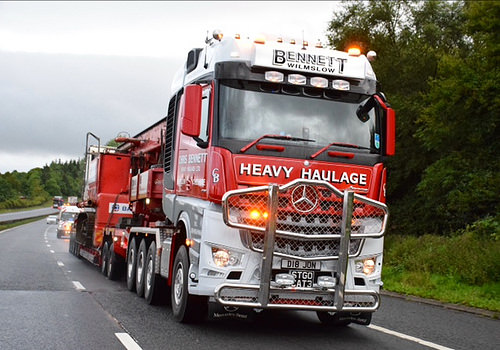Take a look at the Chris Bennett Heavy Haulage fleet and you might think some of our haulage vehicles look unusual. That’s because there’s a haulage vehicle for almost every application, and different vehicles are designed for different uses.
Low Loaders
Low loaders date back to the 1920s and can cater for some of the largest loads. Their dropped deck height – literally a ‘low load’ – means cargo can measure in at 12 feet tall without breaching legal limits.
Semi-low loaders, sometimes called semi-trailers, are an alternative with no front axle. When connected to a tractor unit or cab, the pair form what is commonly known as an articulated lorry, with benefits including easier reversing and convenient uncoupling.
Articulated Flatbeds
An articulated flatbed is an easy option for large loads that do not need to be protected against exposure to weather conditions en route. They do not have a roof or sides – literally just a flat bed suitable for heavy loads. Extendable flatbeds are an option and offer nearly 100 feet of loading length.
Rigid Flatbeds
Rigid flatbeds work on the same principle as articulated flatbeds, and are good for loads that cannot fit inside enclosed transport vehicles. The main difference is that whereas an articulated flatbed trailer must be attached to a tractor unit, a rigid flatbed truck includes both the trailer and the cab, and can therefore drive under its own power.
Mobile Cranes
Mobile cranes are sometimes called Hiabs after the Swedish company Hydrauliska Industri AB (HIAB) which created the innovative vehicles in the mid-1940s. They are equipped with built-in lifting mechanisms and can often be seen stabilised with outriggers during lifting operations.
Beavertail Trucks
A beavertail truck is named after its rear ramp which, like a beaver’s tail, is very low to the ground. This makes it easier to roll machinery on to the rear of the truck, or even to drive a smaller vehicle on to the truck under its own power.
7.5T Tautliner
Our rigid 7.5-tonne tautliner is a great way to transport smaller loads when you want them to stay covered up during transit. With a load capacity of nearly 3 tonnes and side or rear loading, it’s a really convenient way to get small shipments to almost anywhere in the UK.
Tractor Units
A tractor unit is the front part of an articulated lorry, and is usually seen out on the roads with a trailer attached. You might call it a ‘cab’ and it includes the driver’s seat and any overnight accommodation, as well as the front axle of the overall articulated configuration.
Escort Vehicles
Heavy haulage escort vehicles are the outriders that alert other road users to the presence of an abnormal road. Fitted with warning beacons, they are hard to miss and can manoeuvre in ways the main heavy haulage vehicle might find more challenging. This makes them an important addition to any convoy during abnormal operations, and helps to meet the road safety requirements of the police and local authorities.

